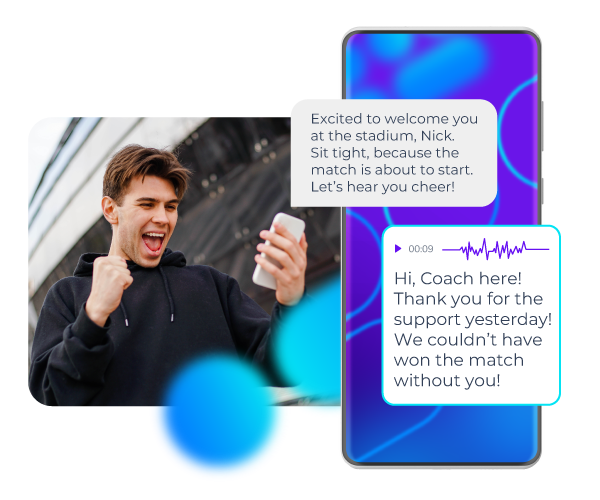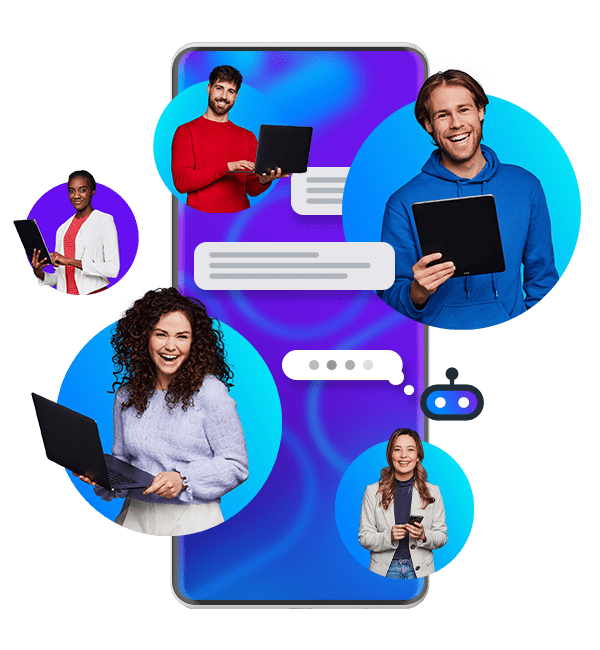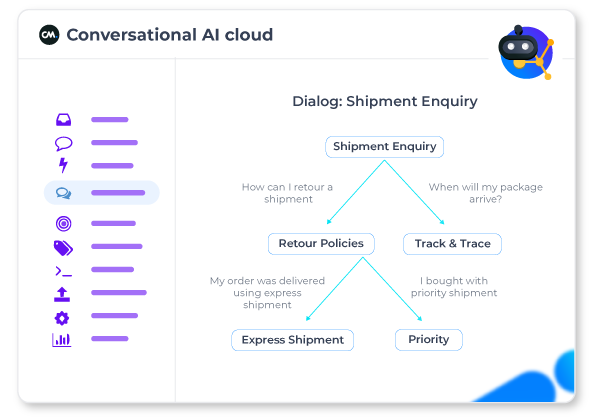Introduction
The pressure on companies to deliver timely, personalized, and fulfilling customer-service experiences is more intense than ever before. According to Microsoft, 95% of consumers say customer service is a key influence in their choice of and loyalty to a brand. While 61% have switched brands due to bad customer service experiences.
A voicebot is a conversational technology capable of having oneto-one conversations with customers using voice alone. As Smart Tribune note, voicebots can ingest, analyze, interpret, and audibly respond to spoken customer inquiries and engage in conversations.
The customer-service industry has long been weighed down by long wait times, overwhelming volumes of customer enquiries, and burnt-out customer-service representatives. To address these issues, customer service departments have increasingly welcomed conversational AI, in the form of chatbots and voicebots, to efficiently deliver satisfying customer service experiences.
What are Conversational Voicebots?
An AI-powered voicebot, dynamically communicates with customers — providing realtime support and answering customer questions in a similar way to chatbots. Unlike chatbots, voicebots have the ability to audibly engage with customers — mirroring virtual assistants like Amazon’s Alexa.

When calling a company, your call might get answered by a bot. This technology is similar to the pre-recorded messages enabling customer to choose a menu option via keypad or speech recognition: Interactive Voice Response (IVR). Nowadays, the technology is way more advanced, providing near-instant answers to customer calls. Artificial Intelligence (AI) and Natural Language Processing (NLP) help voicebots to interpret customer queries and engage in dialogue to resolve issues.
Faster, more intuitive and more human-like.
The Evolution of Customer Conversations
Along the way, customer service communications were enhanced with the likes of Interactive Voice Response (IVR), which enabled automated solutions to instruct and redirect customers to the correct representatives.
From the late 90s and onwards, with the mass adoption of the internet, email and live chat began to rise in popularity. Already in 2018, Microsoft reports that 55% of customers use digital channels such as SMS messages, email, or social media for their customer service interactions.
Since the invention of the call center in the 1960s, which enabled large teams of operators to handle high-volumes of customer service enquiries, phone calls have been the main communication channel for customer-service conversations.
Increasing consumer demands for self-service solutions that are quick and easy to use across channels have led to a wide-spread adoption of conversational AI in customer service — in the form of voicebots and chatbots.
Where is customer service heading? Majorel predicts that robotic process automation (RPA) and artificial intelligence, will handle approximately 69% of all customer service tasks within the next decade.
Read more: How to Use AI to Improve Customer Service? >
The Rise of the ‘Autonomous Customer’
Voicebots empower customers to easily find their own resolutions. Many customers now seek to drive the customer journey. BT refers to this as the rise of the ‘autonomous customer’. Autonomous customers are digitally native and want fast, hassle-free, self-directed problem resolution. AI-powered self-service solutions like voicebots give autonomous customers the control they crave and allow them to solve problems quickly and easily.
As the Harvard Business Review notes, customers are only marginally more loyal when customer services go “above and beyond” — such as providing a discount. Instead, what customers really want is easy problem resolution.
In addition, one of the customer-service industry’s biggest challenges involves balancing the delivery of fast customer service — without burning-out customer service reps. According to Sharpen, two-thirds of customers hang up if they are left to wait longer than two minutes. In addition, 13% of customers believe that customer service departments should answer their calls instantly.
With 24/7 cover and no wait times, voicebots provide near-immediate answers and solutions for customers. As such, voicebots help meet customer expectations and reduce stress for customer-service reps.
Moreover, 56% of customers report having to re-explain an issue — labelling it their biggestcustomer service aggravation. Voicebots integrate and store customer data — reducing customer frustrations and supporting live agents by seamlessly routing out the problems they can’t solve to customer service reps, while providing the information agents need to successfully deliver personalized, accurate customer service.
Advantages of Communication With Voicebots
1. Create a Better Customer Service Experience
Voicebot’s biggest advantage is their ability to deliver a better customer service experience. Poor customer service experiences cost companies an average of $62 billion every year.
As lowering customers’ frustrations around long wait times is fundamental to delivering better customer service, voicebots meet customers’ need for immediacy by responding in real-time. In addition, customers no longer need to type out lengthy messages or questions. As Smart Tribune note, “People can type 53.5 words per minute on a standard keyword, whereas they can speak around 161 words per minute —more than triple the number of words they can type!”

The frustration of having to ask questions repeatedly can also be reduced, thanks to the customer data available via integrations. Intelligent technology gives a complete overview of previous contact moments, their context, questions and even previous purchases. Not only can the implementation of a voicebot reduce frustrations and improve ‘average handling time’, or ‘speed', it will also positively affect your performance on other Customer Service KPIs.
2. Build a Cost-Efficient Customer Service
Voicebots can handle frontline questions and issues, such as customer queries about delivery times or how to find a particular product page on a company’s website. By quickly and efficiently dealing with a high-volume of frontline support tasks, this technology reduces the need to hire a huge number of customer service representatives — reducing hiring costs.
Adding artificial intelligence to your call options, increases scalability. More questions can be answered in a shorter time. Besides, the bot can identify the caller or handle the easy, repetitive questions, freeing up time for customer service reps.
3. Assist Customer Service Representatives to Free up Time
Voicebots take care of the repetitive, menial questions and customer concerns that previously would have taken-up hours of customer service staff member’s day. McKinsey reports that companies that make a concerted effort to improve their customer experience also see employee engagement rates rise by approximately 20%.
By dealing with front-line tasks, voicebots also free up your customer-service representatives to deal with more complex challenges — increasing job satisfaction and reducing costly high-turnover rates. Moreover, happy customer service reps, with enough time to adequately deal with enquiries, can deliver better customer support when they need to.
A voicebot is definitely not a replacement for customer service employees. The combination of a voicebot with human interaction is what will really add value. A bot can take care of the initial questions, make sure the caller gets identified or even handle easy transactions. An easy, seamless handover between bot and employee makes sure the customer has a good service experience. The customer service employee can take over whenever needed, and handle the more complicated questions.
4. Meet Customer Expectations
As customer preferences for communication are ever evolving, it’s key to regularly tune in to the kind of customer service communications that best fit your audience to ensure your meeting expectations.
Expectations are based on personal preferences. Demographics might give guidance for these preferences, but they can differ per person. As one of the most important demographics, soon to flood the workforce, Gen Z use voice notes to talk to their friends far more than older generations. These young consumers also prefer calling, rather than texting — in comparison to millennials. Baby boomers and Generation X appreciate contact via traditional channels prefer to interact with companies via phone calls. As such, voicebots best meet customer expectations of most generations for communications.
Find out more about conversational AI technology and how customers of CM.com are using it for their business.
Why a Voicebot Is The Solution Across Industries
Voicebots are an ideal solution for industries that deal with extensive customer demand, such as the utilities industry, the insurance industry, and the telco service industry.
Here are some of the most common use cases for each industry:
In the utilities sector, companies can use voicebots to efficiently manage high volumes of customer-service inquiries. A recent campaign in Ireland encouraged consumers to direct queries towards and pay their bills via voice technologies. Utility companies use voice technology preliminary to pre-assist customers via phone. Their bot can help customers with a lot of questions but will handover to a live agent when needed.
Insurance providers can use bots to provide instant answers to common insurance queries, such as how to apply for a policy, upcoming renewal dates, and prospective eligibility for a claim.
Banks can use the data derived from customer service interactions to predict future behavior, such as patterns in conversations that typically lead to defaults. Banks can use this data to prevent churn in future customer-service interactions.
In the telecom sector, voicebots can take on the role of advisors — advising consumers on how to make the best choice.
An Introduction to The Technology Used In Voicebots
When customers call a company they expect instant, natural responses to their questions. Whether they are answered by a human customer service agent, or by a bot.
To make this possible, bots need to recognize and interpret customer requests, analyze the information, and compare it to the customer data available. Technologies such as Speech-toText capabilities, Natural Language Processing and Artificial Intelligence help voicebots take in and understand information, and respond in a human way. AI supports the learning process to improve interactions continuously.
Technologies used in voicebots:
Natural Language Processing (NLP)
Artificial Intelligence (AI)
Patterns – Intent Handling
Text-to-Speech
Speech-to-Text
Speech Synthesis Markup Language (SSML)
Dashboarding & analytics
How Do We Use These Technologies?
To offer your customers the best experience via voice, our Conversational AI Cloud embraces various technologies. First and foremost is our NLP and Intent handling. In its basics, the way we understand your customer’s question is the same as understanding questions on written channels like web or WhatsApp Business.

We use a combination of AI and patterns to fully understand what your customer is calling for. This means that if you already have intelligent conversations on web or WhatsApp Business, that same intelligence will be used for questions via the phone as well. You don’t have to build it from scratch. A win-win situation. Since the Conversational AI Cloud does its recognition based on written text, we seamlessly offer Speech-to-text capabilities, all integrated within our solution. This includes speech recognition and transcription for most languagues. If needed, you can always integrate speech recognition APIs.
Meaningful Conversations
After understanding your customer’s question, you want to offer meaningful conversations to assist the customer as best as possible. Similar to conversations on the web, we enable your employees to easily create conversations using our visual conversation editor. To improve the experience even more, your colleagues can design conversations using Speech Synthesis Markup Language (SSML). SSML is a way to make the voicebot sound as humanly as possible. It gives you the power to influence how certain words will be pronounced, add breathing rooms, spell out words or even change the pitch of a sentence. Of course, we made the use of SSML as easy as possible. No coding skills required.
Lastly, you will learn a lot from the conversations your customers have with the voicebot. Our dashboarding and analytics will automatically provide powerful insights in how your customers are interacting and how you can improve. You can see which conversations are not working optimally, for example. To add upon that layer, using our Machine Learning, we provide valuable suggestions on how to improve your conversations.
Set Up Your Own Voicebot
When starting with a voicebot, also known as conversational IVR, you have to think about the purpose. Ask yourself the following questions: Why would you like to start automating? What are your objectives? Is your organization ready? What do you need to get started?
We advise to start small and keep innovating to get the full potential out of your voicebot. The voicebot needs data or input to learn and improve. Depending on data availability and volume of interactions, you can feed your voicebot. Are you already using a chatbot or virtual assistant? You can use this intelligence to help your voicebot get up to speed. You can also insert the 100 most frequently asked questions, for example.
At CM.com we use the “voicebot maturity model” to help our customers to keep on improving and innovating. We look at the maturity of conversational intelligence within your company to see where to start with these technologies.
Level 1: Intake & Classification
The ‘Intake & Classification phase’ is what we mean with start small. This is really a starting point. The voicebot takes care of the intake and classification of the customer before handing over to a live agent. The voice technologies are being used to identify your customer. The bot can ask simple identifiers such as contract number or zip code for a first classification and to route to the right person or department
Level 2: Informational Journey
In the ‘Informational Journey’, your voicebot can answer frequently asked questions (FAQs). Think about questions about order or delivery status. To be able to have informational conversations, it needs more data and input then in the phase before. If the bot cannot answer the question, it hands the call over to a call agent. Informational voicebots are often used outside opening hours or during peak hours, to assist call agents.
Level 3: Transactional Journey
The ‘Transactional Journey’ is even more advanced. Voicebots in this phase can independently complete complex and transactional user journeys. As one would expect, it can still escalate to a live agent when necessary. The bot can help customers make small transactions. Subscribe for an event, change an address, or make changes in your policy.
Level 4: Personalized Journey
Innovative companies are able to use personalized voicebots in the ‘Personalized Journey’. In this phase, integrations with the backend are in place, enabling the voicebot to autonomously handle user specific journeys. The bot has full access to customer data, offering a fully personalized experience based on a rich customer profile. Personalized voicebots are capable of handling conversions and transactions in a seamless experience. Book a trip, change monthly payments or report damage in a highly personalized way.
Start with Conversational AI
Set to revolutionize the customer services industry, voicebots promote customer autonomy and provide the immediate answers customers are looking for. Their ability to provide 24/7 support to high volumes of customers helps reduce effort and frees up time for customer service agents.
Now you have read more about voicebots, you probably have ideas on how it could help your organization. Regardless of the maturity, the time for a voicebot is now. Make sure you get the organization on board. Every company has his or her own starting point, but there are always voicebot capabilities that match your starting point. Find out more on Conversational AI, voicebots and chatbots on CM.com.








